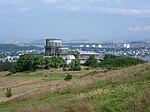Comiston

Comiston (Scottish Gaelic: Baile Chaluim, IPA:[ˈpaleˈxaɫ̪ɯim]) is a suburb of Edinburgh, the capital of Scotland. It is south of Morningside and west of the Braid Hills, linking the suburbs of Oxgangs and Fairmilehead. The main road through the area, Comiston Road, is a continuation of Morningside Road, and further south becomes Biggar Road. It is classified as the A702 which runs eventually to Biggar. A part of Comiston Road has signage as Pentland Terrace, the name of a terrace of Victorian houses set back from, and above Comiston Road, with a roadway of its own immediately in front of the houses. Comiston House was owned by the Forrest baronets. Sir James Forrest, 1st Baronet, Lord Provost of Edinburgh, occupied it from 1837 to 1843. Its grounds now form Fairmilehead Public Park.
Excerpt from the Wikipedia article Comiston (License: CC BY-SA 3.0, Authors, Images).Comiston
Pentland Crescent, City of Edinburgh Fairmilehead
Geographical coordinates (GPS) Address Nearby Places Show on map
Geographical coordinates (GPS)
| Latitude | Longitude |
|---|---|
| N 55.910355555556 ° | E -3.2136305555556 ° |
Address
Pentland Crescent 16
EH10 6NS City of Edinburgh, Fairmilehead
Scotland, United Kingdom
Open on Google Maps









